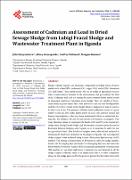| dc.contributor.author | Kyayesimira, Juliet | |
| dc.contributor.author | Ssemaganda, Abbey | |
| dc.contributor.author | Muhwezi, Godfrey | |
| dc.contributor.author | Andama, Morgan | |
| dc.date.accessioned | 2020-02-11T09:32:42Z | |
| dc.date.available | 2020-02-11T09:32:42Z | |
| dc.date.issued | 2019 | |
| dc.identifier.citation | Kyayesimira, J. , Ssemaganda, A. , Muhwezi, G. and Andama, M. (2019) Assessment of Cadmium and Lead in Dried Sewage Sludge from Lubigi Feacal Sludge and Wastewater Treatment Plant in Uganda. Journal of Water Resource and Protection, 11, 690-699. doi: 10.4236/jwarp.2019.116040. | en_US |
| dc.identifier.issn | 1945-3094 (Print) | |
| dc.identifier.issn | 1945-3108 (Online) | |
| dc.identifier.uri | http://dir.muni.ac.ug/xmlui/handle/20.500.12260/335 | |
| dc.description.abstract | Sludge contains organic and inorganic compounds including traces of heavy metals such as lead (Pb), cadmium (Cd), copper (Cu), nickel (Ni), chromium (Cr) and others. These metals restrict the use of sludge in agriculture because their accumulation is harmful to the environment and particularly the food chain. Cadmium and lead are among the most common heavy metals found in municipal wastewater treatment plant sludge. They are capable of bioaccumulation in plant tissues like roots and leaves and are non-biodegradable and therefore they remain in the sludge which is disposed on land or used as fertilizers on farms. The presence of heavy metal pollutants serves as a great threat to soils and also makes plants grown on such soils unfit for animal and human consumption as they may have detrimental effects to animal and human life. For instance, Pb and Cd are known to be human carcinogens. This study therefore aimed to investigate the levels of Cd and Pb in the treated dry sludge from Lubigi Feacal Sludge and Wastewater treatment plant located in Kawempe division, Kampala city, Uganda so as to ascertain its safety for use on agricultural lands. Two batches of samples were collected and analyzed at Government Analytical laboratory in Wandegeya, Uganda. The acid digested sludge samples were analyzed using Atomic Absorption Spectroscopy (AAS) method. The average concentrations of Pb found in collected sludge samples, batch 1 (11.912 mg/kg dm) and batch 2 (5.304 mg/kg dm) were far below the Environment Protection Agency (EPA) maximum permissible concentration (840 mg/kg) for any land application. Cadmium was not detected in all the sludge samples collected; there is an implication that it is either completely absent in the sludge generated by the plant or present but far below detectable levels. The sludge generated from Lubigi fecal sludge and wastewater treatment plant is therefore safe for application on agricultural lands as far as Pb and Cd concentrations are concerned. | en_US |
| dc.language.iso | en | en_US |
| dc.publisher | Journal of Water Resource and Protection | en_US |
| dc.relation.ispartofseries | Vol.11;No.6 | |
| dc.subject | Lead | en_US |
| dc.subject | Cadmium | en_US |
| dc.subject | Sludge | en_US |
| dc.subject | Wastewater | en_US |
| dc.subject | Treatment | en_US |
| dc.subject | Uganda | en_US |
| dc.title | Assessment of Cadmium and Lead in dried sewage sludge from Lubigi feacal sludge and wastewater treatment plant in Uganda | en_US |
| dc.type | Article | en_US |

